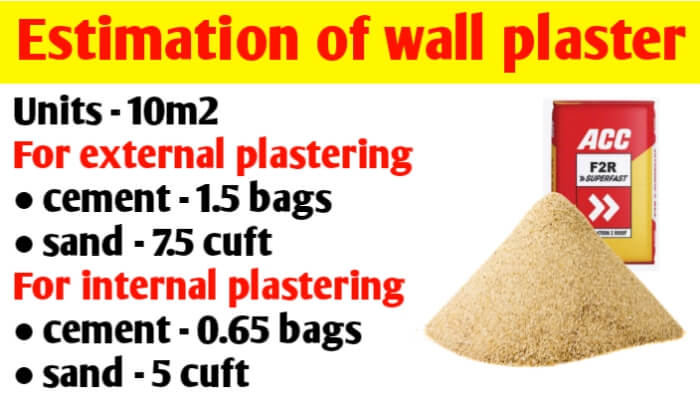Estimation of wall plaster | estimation for internal wall plastering | estimation for external wall plastering | quantities of materials cement sand required for wall plastering.
Plastering is thin layer of materials used to cover wall and ceiling and to make it surface smooth and good finish. Plastering is used for protection and decorative coating of wall and ceiling and their moulding and casting decorative element such as internal wall, external wall, ceiling and RCC surfaces. In plastering design you should provide thin layer of cement mortar in exterior and interior wall of building. In English plaster means of material used for interior building and the term “Render” is used for external application.
Plastering design used several product for interior house design such as ceramics, bricks, stone, cement, plaster of Paris (pop), gypsum plaster, vedic plaster and lime plaster.
The plaster in also one of easiest material to prepare and it can be used in different areas of your home like kitchen, living room, bathroom and to cover ceiling.
We have different types of plaster cast. Mainly it is categorised into 4 types of plaster according to their binding material such as 1) cement plaster, 2) gypsum plaster, 3) clay plaster, 4) lime plaster & 5) POP plaster. One of the best binding material is cement plaster which is adhesive material to make strong bond between plaster layer and wall surfaces.
Cement plaster is a type of binding material in which cement is used as Binder and it has water resistance but not waterproof and it is also weather resistance for wall plaster. cement plaster is mix of cement, sand and water in required proportion. Cement plaster is used widely for plastering of wall and interior and exterior designing.
According to their application plastering have several types such as 1) external plastering, 2) internal plastering, 3) ceiling plastering and
4) RCC surface plastering.
Coating of plastic material on the exterior of wall is known as exterior plastering, coating of plastering material on the interior face of wall is known as interior plastering. And also cement mortar is coated on the roof ceiling that is known as ceiling plaster and some RCC surface of column and beam they have provided plastering coat that is known as rcc surface plastering.

In this article we briefly discuss about estimation of wall plaster, estimation for internal wall plastering, estimation for external wall plastering, quantities of materials cement sand required for wall plastering.

Estimation of wall plaster such as internal and external wall depending on mainly two factors thickness of cement plaster and mortar mix ratio. Recommended Mix ratio for external brick/ block wall plastering is about 1:4 in which 1 part cement to 4 part sand and thickness of external brick wall plastering is about consists of two coat first Coat of 12 mm and second coat of 8 mm that is aggregate thickness of external brick/ block wall plastering is 20 mm. Recommended Mix ratio for internal brick/ block wall plastering is about 1:6 in which 1 part cement to 6 part sand and thickness of internal brick wall plastering is about 12 mm.
Estimation of wall plaster
For external plastering
● dimension of brick wall = 4 m × 2.5m
● Area of platering work = 10 m2
● Thickness of plastering = 20 mm or 0.02m
● wet volume of plastering quantity = Area × thickness such as 10m2× 0.02 m = 0.2 m3
● Dry volume of plastering quantities = 1.33 × 0.2 m3 = 0.266 m3, to calculate dry volume of cement mortar, wet volume of cement mortar is multiply with cofactor 1.33
● mix ratio for external brick wall plastering is about 1:4, so total proportion = 1+ 4 =5, parts of cement = 1/5 & parts of sand = 4/5
● Estimation for quantity of cement required for external brick wall plastering = 1/5 × 0.266m3 × 1440kg/m3 = 76.6 kg, or this is approximately equal to 1.5 bags of cement
● Estimation for quantity of sand required for external brick wall plastering = 4/5 × 0.266m3 = 0.21 m3, or this is approximately equal to 7.5 cuft or 340 kg of sand.
ALSO READ :-
Plaster sand near me, delivery, colour and 25kg or bulk bag
Cement to sand ratio for mortar, brickwork and plastering
How to calculate plastering quantity | cement sand ratio
How to calculate the quantity of material for plaster
Plaster cost per square foot with material in India
For average estimate of external wall plastering, generally you need 1.5 bags (approx 77kg) of cement and 0.21 m3 (7.5 cuft or 340 kg) of sand quantities for 10 square metre of plastering work if mix ratio is 1:4 (1 part cement to 4 parts sand)and thickness of plaster is 20 mm.
◆You Can Follow me on Facebook and
Subscribe our Youtube Channel
For internal wall plastering
● dimension of brick wall = 4 m × 2.5m
● Area of platering work = 10 m2
● Thickness of plastering = 12 mm or 0.012m
● wet volume of plastering quantity = Area × thickness such as 10m2 × 0.012 m = 0.12 m3
● Dry volume of plastering quantities = 1.33 × 0.12 m3 = 0.1596 m3, to calculate dry volume of cement mortar, wet volume of cement mortar is multiply with cofactor 1.33
● mix ratio for internal brick wall plastering is about 1:6, so total proportion = 1+ 6 =7, parts of cement = 1/7 & parts of sand = 6/7
● Estimation for quantity of cement required for internal brick wall plastering = 1/7 × 0.1596m3 × 1440kg/m3 = 33 kg, or this is approximately equal to 0.65 bags of cement
● Estimation for quantity of sand required for internal brick wall plastering = 6/7 × 0.1596 m3 = 0.14 m3, or this is approximately equal to 5 cuft or 220 kg of sand.
For average estimate of internal wall plastering, generally you need 0.65 bags (approx 33kg) of cement and 0.24 m3 (5 cuft or 220 kg) of sand quantities for 10 square metre of plastering work if mix ratio is 1:6 (1 part cement to 6 parts sand)and thickness of plaster is 12 mm.